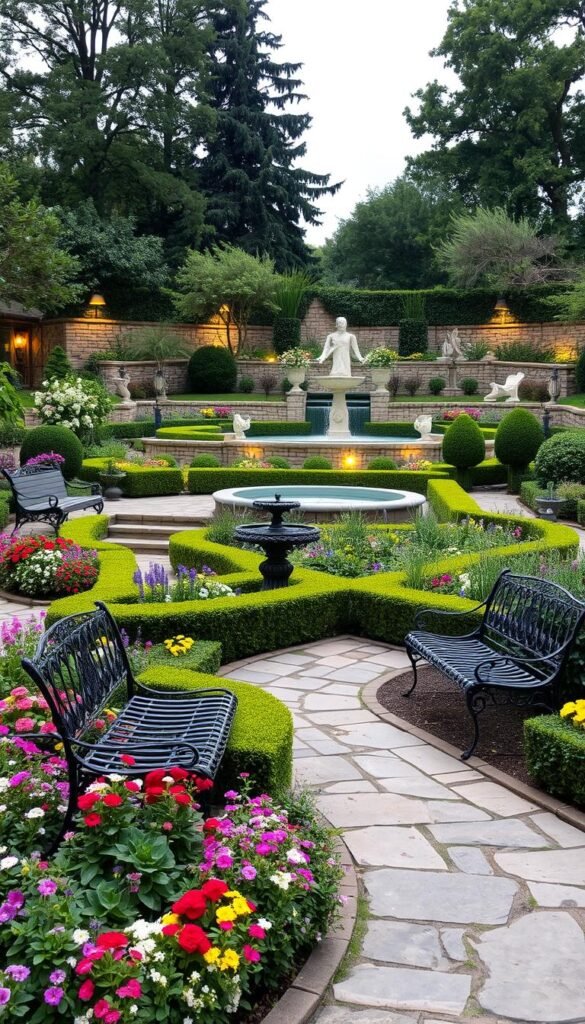Your backyard can tell a story that spans generations. By combining weathered treasures with sleek accents, you craft an environment that feels both nostalgic and fresh. Imagine a rusted iron bench paired with crisp geometric planters or repurposed barn wood framing smooth concrete stepping stones.
A thoughtful color palette ties everything together. Earthy neutrals like sage and terracotta create harmony between eras, while metallic finishes add subtle contrast. This approach works whether you’re styling a cozy balcony or sprawling yard – practical tips for outdoor living show how to maximize any space.
The magic happens when you balance proportions. Let a statement antique anchor your design, then surround it with minimalist touches. For example, hang string lights above a century-old fountain or place succulents in retro ceramic pots beside angular furniture.
Your home‘s exterior becomes an extension of your personality through these curated combinations. Local flea markets often hold unexpected gems, while modern garden centers provide clean-lined pieces. Together, they form a living canvas that evolves with time yet always feels intentional.
Understanding the Fusion of Vintage and Modern Garden Styles

Gardens become captivating when past and present collide thoughtfully. This blend creates spaces where history meets innovation, offering both charm and practicality. Let’s explore how combining eras can transform your outdoor area into a layered retreat.
Exploring the Timeless Appeal of Vintage Pieces
Weather-worn items carry stories that new fixtures can’t replicate. A chipped stone urn or wrought-iron gate adds character through imperfections. These pieces often feature handcrafted details missing in mass-produced items, making them focal points.
Modern Trends That Enhance Your Outdoor Space
Sleek lines and smart tech bring freshness to aged accents. Think vertical planters beside a cracked sundial or solar lights illuminating antique statues. Current styles prioritize low-maintenance materials like powder-coated steel, balancing beauty with function.
| Feature | Vintage Approach | Modern Approach |
|---|---|---|
| Materials | Reclaimed wood, wrought iron | Concrete, composite resins |
| Function | Ornamental focus | Multi-purpose designs |
| Color Palette | Muted earth tones | Bold monochromes |
Pairing strategies matter. Use neutral cushions on a retro bench or grow trailing vines in geometric planters. This interplay lets each style shine without competing.
Defining Your Garden’s Design Vision
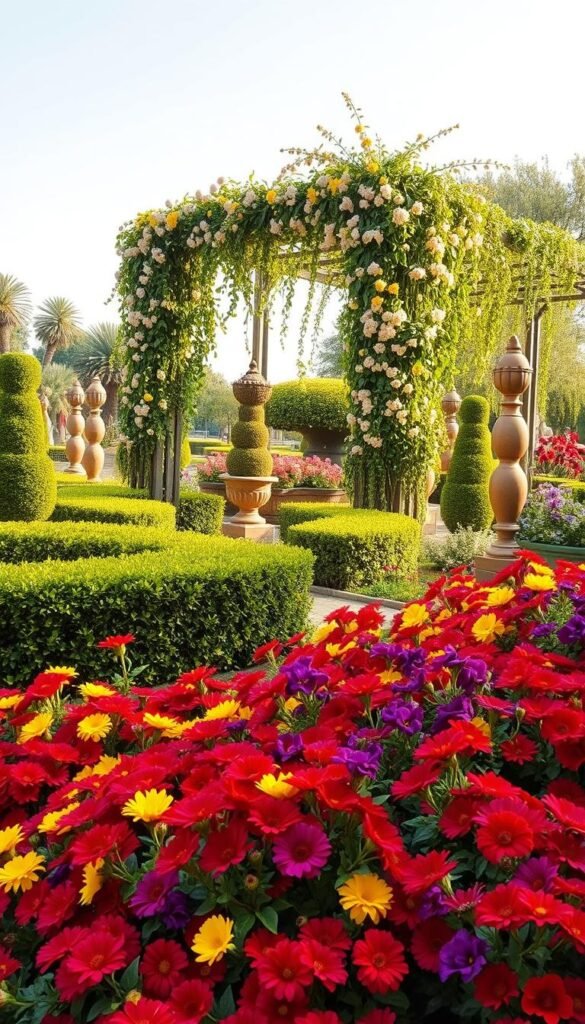
Your outdoor space deserves a clear direction that reflects your personality. Start by imagining how you want to feel when relaxing in your garden – serene, energized, or inspired? This vision guides every choice, from furniture shapes to textured decor items.
Selecting a Cohesive Color Palette and Style
Choose 2-3 base hues that complement your home’s exterior. Soft greens and warm browns create calm, while navy or charcoal adds drama. Stick to these tones for wood finishes, cushions, and decorative items to unify the space.
Balance old and new through materials. A weathered teak table pairs beautifully with sleek metal chairs. Add patterned throw pillows in your chosen color scheme to tie different eras together.
| Style | Primary Colors | Accent Materials |
|---|---|---|
| Earthy Neutrals | Sage, Terracotta | Reclaimed wood, Stone |
| Monochromatic | Slate Gray, White | Powder-coated metal, Concrete |
| Bold Contrasts | Navy, Mustard | Glazed ceramic, Tempered glass |
Layer textures to make your room feel complete. Woven rugs underfoot, smooth stone pathways, and rough-hewn planters create interest. Group similar-toned items in odd numbers for visual harmony.
Test your palette with small accents first. Paint a vintage stool your main hue or add modern throw blankets in accent shades. These experiments help refine your vision before committing to larger pieces.
Mixing Vintage & Modern Elements for a Timeless Garden Look
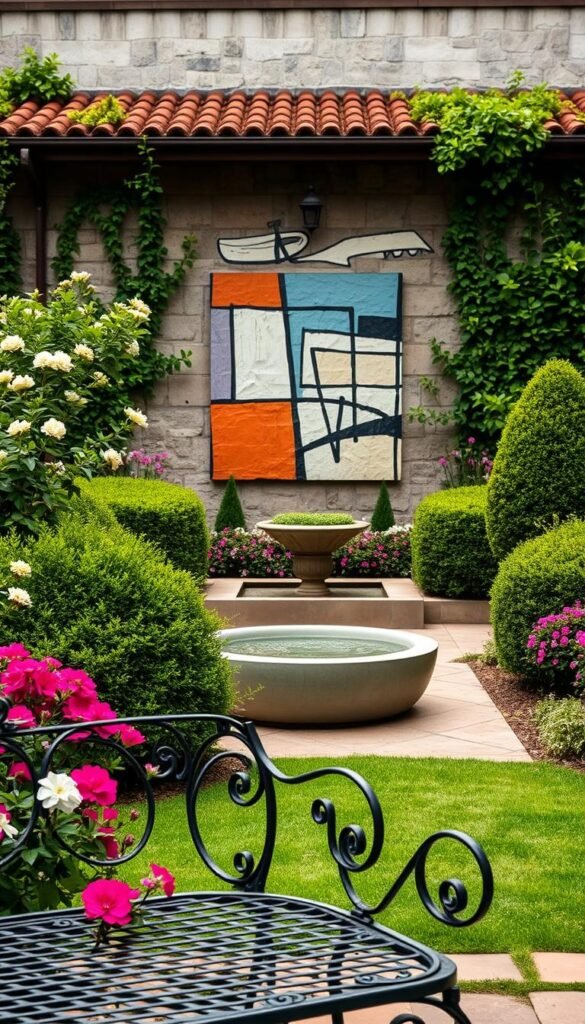
Outdoor areas gain depth when history and innovation coexist. The secret lies in pairing aged treasures with practical updates that serve today’s needs. Think of it as curating a living museum where every piece contributes to both warmth and efficiency.
Balancing Antique Charisma with Contemporary Functionality
Start with seating that tells two stories. An ornate iron bench gets new life with weather-resistant cushions, while a sleek fire pit nearby offers modern convenience. This mix keeps your spaces inviting through all seasons.
Choose accessories that bridge time periods. Aged terracotta pots housing drought-tolerant plants beside solar-powered lanterns create visual rhythm. Stick to a neutral palette with muted greens and grays to unite different eras.
Using Statement Pieces to Anchor Your Design
Let one bold item command attention. A restored sundial becomes a focal point when surrounded by minimalist gravel paths. Layer warmth with textured throws on clean-lined furniture nearby.
Your decorating choices should spark joy and function. Hang vintage-inspired wind chimes near contemporary seating areas. Cluster mismatched lanterns in similar metallic finishes along walkways to guide the eye.
Remember to leave breathing room. Too many accessories clutter the story. Edit ruthlessly, keeping only items that enhance your mix of old and new. This approach ensures every corner feels intentional yet effortless.
Practical Steps for a Garden Transformation
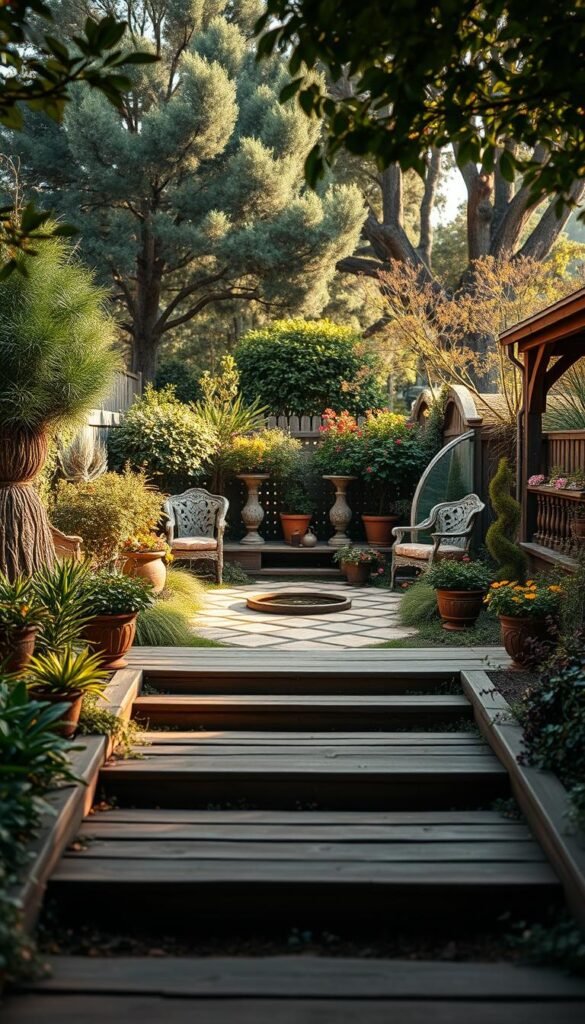
Revamping your outdoor space becomes effortless when you know where to hunt for treasures and how to layer them. Start by defining zones that serve different purposes – dining, relaxing, or showcasing art. This creates natural flow while letting you experiment with diverse ideas.
Sourcing Unique Vintage Finds and Modern Fixtures
Scour flea markets for weathered planters or salvaged gates that ooze character. Local estate sales often hide gems like wrought-iron chairs or ceramic statues. Pair these with crisp, geometric planters from contemporary retailers for contrast.
Online auctions offer another way to discover rare items. Look for chipped garden urns or retro signage that tells a story. Balance these with modular seating or solar-powered lights for modern convenience.
| Source Type | Vintage Finds | Modern Fixtures |
|---|---|---|
| Physical Stores | Antique tool racks | Vertical planters |
| Online Markets | Repurposed barn wood | Smart irrigation systems |
| DIY Projects | Hand-painted tiles | Laser-cut metal art |
Implementing Layered Design Techniques
Create depth by stacking textures and heights. Place trailing colorful container gardening flowers in raised planters behind low-growing succulents. Add interest with a mix of smooth stones, rough bark mulch, and polished glass accents.
Use statement pieces as anchors – like a carved bench under a contemporary pergola. Cluster smaller vintage items in groups of three on sleek shelves. This way, every corner feels curated yet spontaneous.
Rotate seasonal art installations to keep the space dynamic. Hang mosaic wind chimes beside abstract metal sculptures. These touches inject personality while maintaining visual harmony between eras.
DIY Tips and Tricks for Crafting Your Garden Style

Transform your outdoor area without draining your wallet. With clever upcycling and smart shopping, you can blend old new elements into a space that feels uniquely yours. Start by hunting for forgotten treasures in your garage or local thrift stores – that chipped chair or rusty lantern might become your next showstopper.
Budget-Friendly Projects to Personalize Your Space
Give vintage pieces fresh purpose. Turn an antique ladder into a vertical herb garden or convert mismatched teacups into quirky succulent planters. These projects add personality while keeping costs low. Pair them with modern decor like geometric string lights for visual balance.
Refresh your color scheme with spray paint. A coat of matte black instantly unifies weathered metal chairs, while pastel hues soften angular concrete planters. Stick to 2-3 shades that complement your home decor for a polished look.
Merge function and style through simple upgrades. Add cushioned seats to a salvaged bench using outdoor fabric, or install solar-powered bulbs in retro-style fixtures. These tweaks make your interior design skills shine outdoors without costly renovations.
Remember: Great spaces evolve. Start small with one DIY project, then build around it. Before long, you’ll create a garden that mirrors your creativity while staying budget-savvy.
Avoiding Common Pitfalls in Blending Design Styles
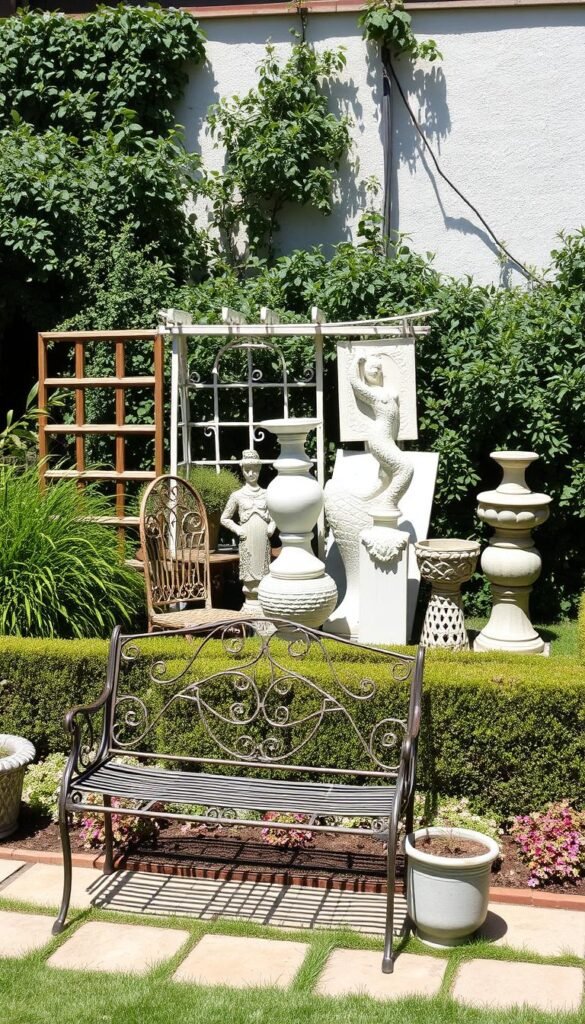
Ever walk into a garden that feels like two separate spaces arguing? Many homeowners accidentally create this clash by overcrowding with mismatched items. The secret lies in strategic editing – keep pieces that share a balance of form and function.
One frequent error? Using too many statement pieces. A carved stone bench competes with angular furniture when placed side-by-side. Instead, separate bold items with neutral zones using similar textures like gravel or moss.
| Common Mistake | Smart Solution |
|---|---|
| Clashing materials (rustic wood + glossy plastic) | Use transitional elements like weathered steel |
| Ignoring home feel continuity | Repeat indoor color schemes outdoors |
| Overdoing “shabby chic” charm | Limit distressed items to 30% of space |
Scale issues often disrupt harmony. A tiny bistro table gets lost beside a massive antique urn. Fix this by grouping smaller vintage finds on modern shelving units. This creates visual weight that matches larger contemporary pieces.
Your interior style should whisper through your garden. If your living room features mid-century lines, echo them in planter shapes. Add warmth through similar cushion fabrics or ceramic glazes used indoors.
Remember: Great spaces feel collected, not chaotic. Edit ruthlessly and test layouts by photographing angles. This ensures your home feel remains cohesive while celebrating thoughtful contrasts.
Incorporating Natural Elements and Textures
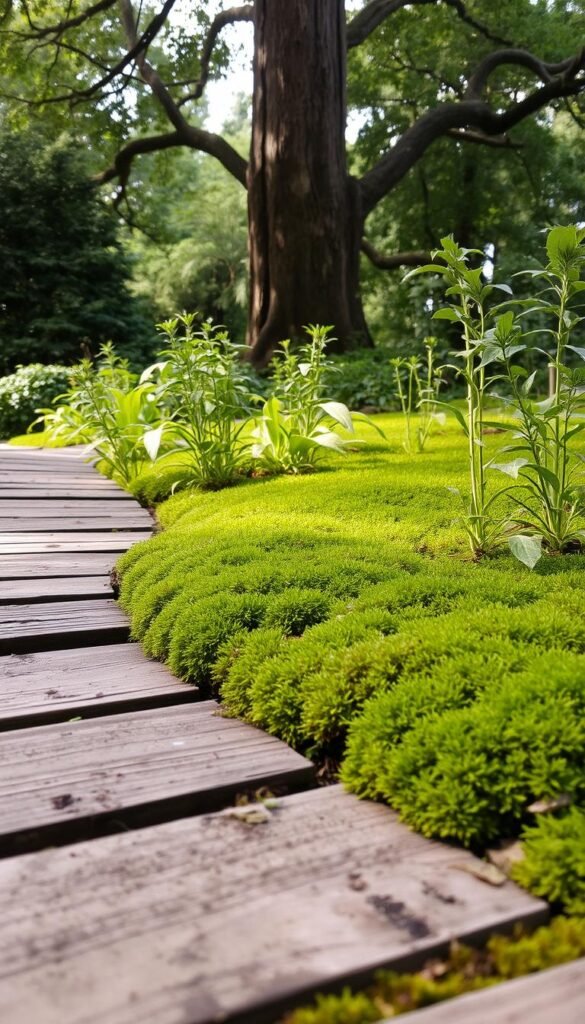
Blending natural textures transforms gardens into multi-sensory retreats. Rough-hewn stone paths underfoot, weathered cedar benches, and feathery grasses swaying in the breeze create layers of touch and visual intrigue. These organic components work overtime to soften hard edges and invite lingering moments outdoors.
Integrating Wood, Stone, and Greenery for Warmth
Wood brings instant warmth through its grain patterns and natural tones. Try pairing reclaimed barnwood planters with smooth river rocks for contrast. Stack slate slabs as stepping stones between raised beds overflowing with living herbs – their fragrant leaves add another sensory layer.
| Material | Texture Impact | Color Pairing Tip |
|---|---|---|
| Driftwood | Weathered, soft edges | Pair with slate gray pebbles |
| Fieldstone | Rugged, irregular surfaces | Complement with mossy greens |
| Bamboo | Linear, smooth poles | Offset with terracotta pots |
Strategic lighting amplifies these textures after dark. Low-voltage path lights grazing a stone wall reveal its pitted surface, while pendant bulbs hung in birch branches cast dappled shadows. For natural materials that age beautifully, choose untreated woods and unsealed stones that develop patinas over time.
Greenery acts as the ultimate unifier. Train ivy over a stacked stone wall or let ornamental grasses spill from container gardening vessels. These living elements introduce movement while softening transitions between different colors and materials in your design.
Final Thoughts on Creating a Timeless Garden Charm
Crafting an outdoor retreat that feels both curated and effortless starts with intentional choices. By focusing on a cohesive color scheme and thoughtful placement, you unite different eras into a harmonious whole. Earthy neutrals act as your foundation, letting weathered patinas and sleek finishes complement rather than compete.
Textiles become secret weapons in bridging design eras. Weather-resistant cushions in muted tones add comfort to aged benches, while patterned throws tie contemporary seating areas to rustic accents. These fabric layers introduce warmth without overwhelming the senses.
Your space should evolve as you discover new ways to express creativity. Share unique DIY projects with neighbors or swap plant cuttings to add fresh perspectives. Explore unexpected ways to style vertical gardens or arrange container displays for visual intrigue.
Timeless charm emerges from consistency, not perfection. Regularly edit elements that no longer serve your vision, and celebrate pieces that spark joy. With playful experimentation and clever ways to blend old with new, your outdoor haven will remain inviting for countless seasons ahead.

